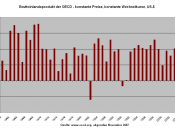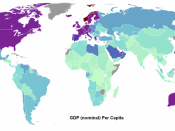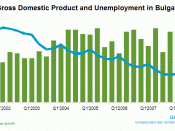Home Depot
Real Gross Domestic Product (real GDP)
Gross Domestic Product (GDP) is the measurement of growth within an economy. This indicator is widely used by economists when doing research and forecasting efforts. GDP is defined by Colander (2004) as "the market value of final goods and services produced in an economy, stated in the prices of a given year" (p. 2).
( Bureau of Economic Analysis, 2006)
According to Steve Goldstein (2006), "Home Depot rose 3% in the pre-open after it earned $1.3 billion, or .60 cents a share in the fourth quarter" (para. 9). This increase is up from .47 cents a share or $1 billion within the last year. The revenue for Home Depot has risen 16% while store sales were up. The Gross Domestic Product (GDP) according to the Bureau of Economic Analysis had a slow-down in the fourth-quarter growth. This primarily reflects a deceleration in consumer spending (2006, para.
2). The annual growth for GDP was 3.5% which was unchanged fromt the estimate in February.
Producer Price Index (PPI)
Producer price index (PPI) serves as an early indication of inflation each month. According to Colander (2004), "The producer price index (PPI) is an index of prices that measures average change in the selling prices received by domestic producers of goods and services over time" (p. 22). This index also includes the goods that consumers may not purchase. PPI's capture price movement so that the Government may be able to track price changes for businesses. This also allows the government to use fiscal and monetary policies in dealing with the changes in prices that are reflected in the PPI.
(Marketwatch, 2006)
In a recent MarketWatch report Goldstein and Kilgore reported that, "Home improvement retailer and Dow industrial component Home Depot gained 1.02, or 2.4% to $43.59...


